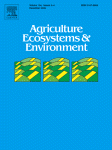Ver ítem
- xmlui.general.dspace_homeCentros Regionales y EEAsCentro Regional Buenos Aires NorteEEA Delta del ParanáArtículos científicosxmlui.ArtifactBrowser.ItemViewer.trail
- Inicio
- Centros Regionales y EEAs
- Centro Regional Buenos Aires Norte
- EEA Delta del Paraná
- Artículos científicos
- Ver ítem
The combination of crop diversification and no tillage enhances key soil quality parameters related to soil functioning without compromising crop yields in a low-input rainfed almond orchard under semiarid Mediterranean conditions
Resumen
Soils provide key ecosystem services and are crucial to combat climate change. Agriculture provides important ecosystem services but also causes negative environmental effects depending on agricultural management. In this regard, crop diversification is a promising sustainable land management strategy to combat soil erosion and degradation, mitigate climate change and ensure food security. Here, we assess the combined short-term effects of crop
[ver mas...]
Soils provide key ecosystem services and are crucial to combat climate change. Agriculture provides important ecosystem services but also causes negative environmental effects depending on agricultural management. In this regard, crop diversification is a promising sustainable land management strategy to combat soil erosion and degradation, mitigate climate change and ensure food security. Here, we assess the combined short-term effects of crop diversification and no tillage on several key soil physico-chemical parameters related to soil functioning as well as on crop yields in a rainfed almond (Prunus dulcis Mill.) orchard under semiarid Mediterranean conditions. Almond trees were inter-cropped with Capparis spinosa L. (caper) or Thymus hyemalis Lange (winter thyme) and compared with the almond monocrop system. The experimental design consisted of three plots in a randomized-block design, with three replicates for each crop management treatment (almond monocrop, almond inter-cropped with caper, and almond inter-cropped with winter thyme). Along with crop yields, the combined effects of crop diversification and no tillage on a range of soil quality and health indicators including soil physical (bulk density, aggregate stability, water retention and availability) and chemical (total and particulate organic carbon and nitrogen, ammonium and nitrate content, available macro- and micro-nutrients) properties were monitored in the topsoil and subsoil (at 0–10 and 10–30 cm depth, respectively) one and three years from establishment.
[Cerrar]

Autor
Almagro, María;
Díaz-Pereira, Elvira;
Boix-Fayos, Carolina;
Zornoza, Raúl;
Sánchez-Navarro, Virginia;
Re, Paula;
Fernández, Cristina;
Martínez-Mena, María;
Fuente
Agriculture, Ecosystems & Environment 345 : 108320 (April 2023)
Fecha
2023-04
Editorial
Elsevier
ISSN
0167-8809
1873-2305
1873-2305
Formato
pdf
Tipo de documento
artículo
Palabras Claves
Derechos de acceso
Abierto
 Excepto donde se diga explicitamente, este item se publica bajo la siguiente descripción: Creative Commons Attribution-NonCommercial-ShareAlike 2.5 Unported (CC BY-NC-SA 2.5)
Excepto donde se diga explicitamente, este item se publica bajo la siguiente descripción: Creative Commons Attribution-NonCommercial-ShareAlike 2.5 Unported (CC BY-NC-SA 2.5)

